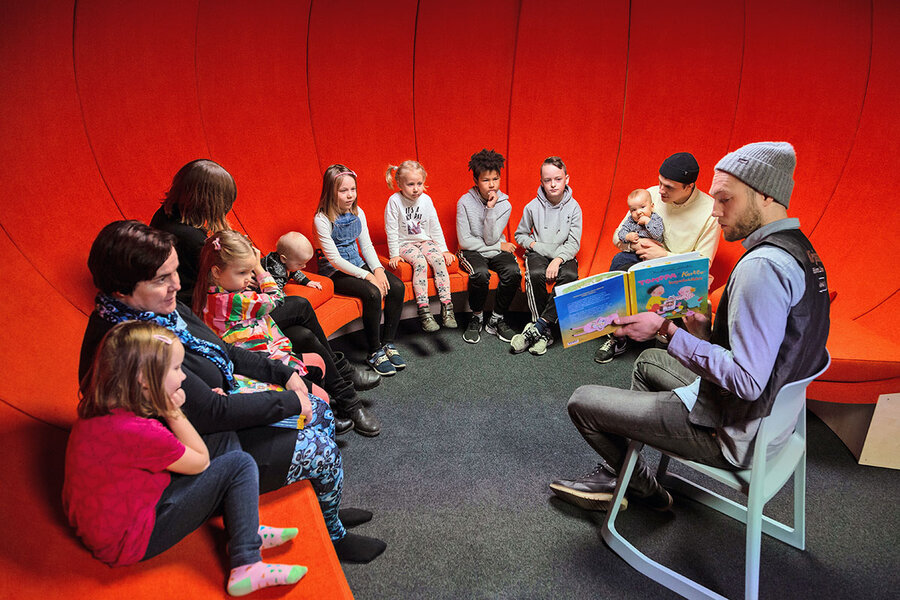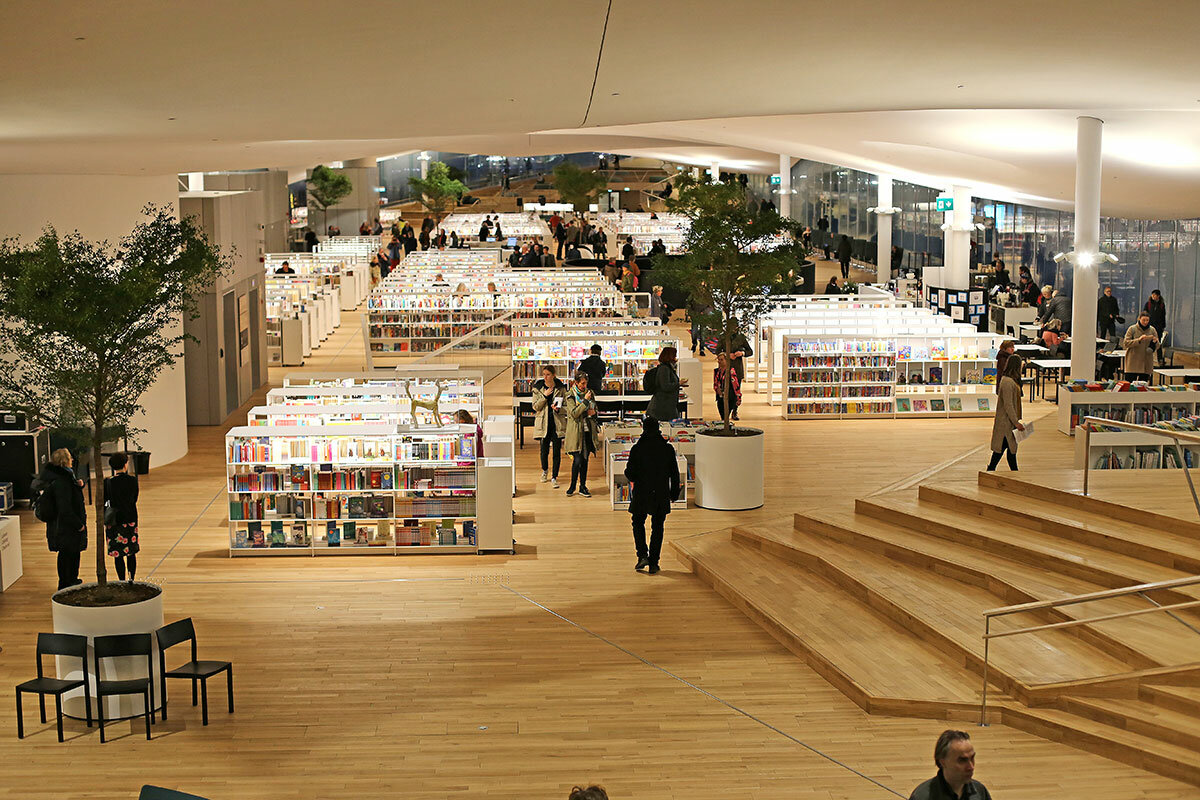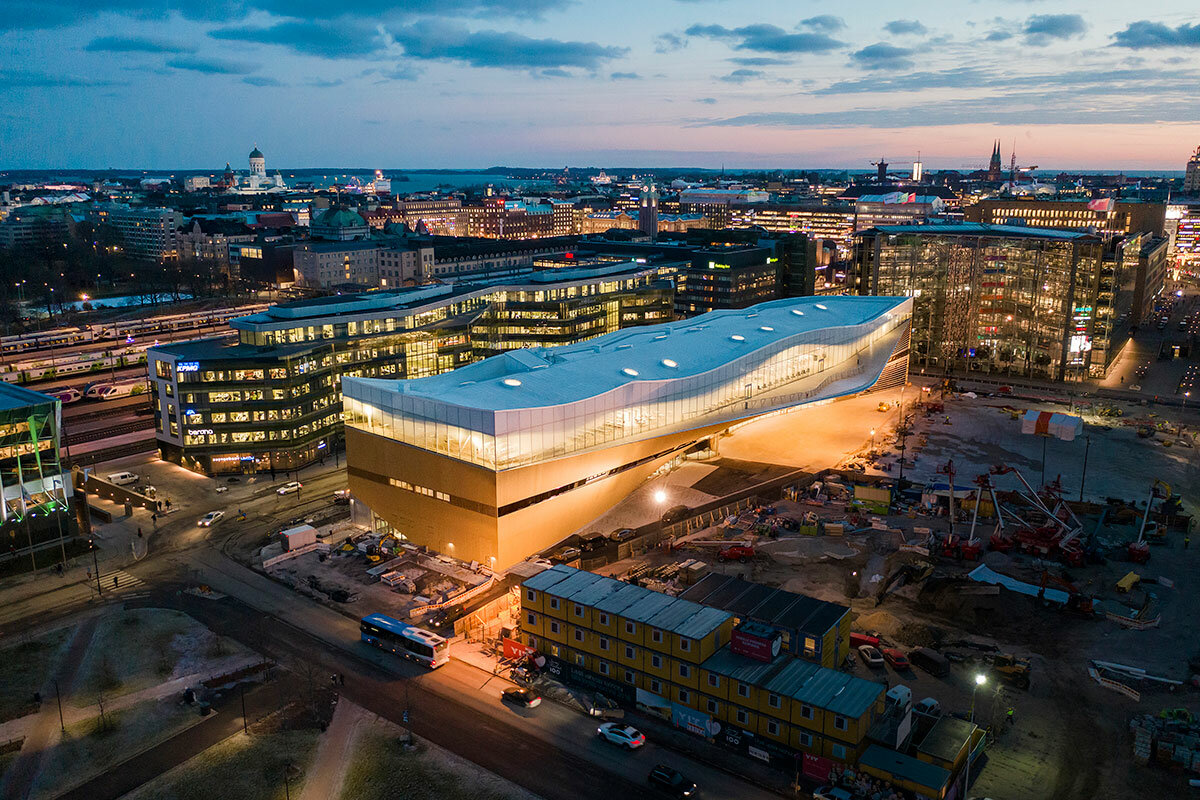Welcome to Oodi: Helsinki’s new ‘living room’
Loading...
| Helsinki, Finland
The Finns like to call their country a “design nation,” one with a natural affinity for devising creative and efficient solutions for both spatial and social challenges.
With the opening last month of Oodi, the barrier-breaking Helsinki Central Library, one of Europe’s most design-conscious countries has a library that matches that motto, as well as one which reflects its democratic ambitions. Oodi – which means “ode” in Finnish – “is not just a library,” says Tommi Laitio, Helsinki’s executive director of culture and leisure. “It’s also a symbol of the goals we have as a society.”
According to Antti Nousjoki, one of the partners at ALA Architects, the Finnish firm behind the monumental $110 million, spaceship-like building, the designers’ objective was to create a library that empowered its users. “Oodi does not relegate citizens to the role of spectator or dictate single functions and possibilities,” says Mr. Nousjoki, “but rather acts as an open platform and tool for people to develop as they see fit.”
Why We Wrote This
The new Helsinki Central Library, known as Oodi, doesn't just lend out books. It hosts community spaces, a theater, toolshops, and even a restaurant, all in an effort to promote Finnish civil society.
So if the building, which is sited at the entrance to the Helsinki peninsula, at the apex of the capital’s new metropolitan mall, also serves as a living monument to Finnish democracy, so much the better, says Nousjoki.
Oodi being foremost a library, books certainly have their place. The entire third floor – a soaring, tree-lined, open space dubbed “book heaven” – is devoted to them. The moniker is appropriate for a country that prides its status as the most literate in the world.
“Books hold a central place in the Finnish imagination,” says Raoul Grunstein, a former magazine publisher and the founder of Töölö Urban, an urban development firm. His firm created the Korjaamo Culture Factory and the Allas Sea Pool, two public spaces that have helped change the self-image of this once hidebound harborside town. “Finland was a backward country in the 19th century.... Books and reading, as well as libraries, were crucial in the growth of civil society. It’s fitting and wonderful that Helsinki has a library – and a creative public space – which helps celebrate and extend that tradition.”
Only 100,000 books are actually stored at Oodi. Indeed, one of the criticisms of the futuristic facility is that its collection is too small. However, users can readily access the 5.5 million volumes in the Finnish library system, which are delivered by autonomous book trolleys. Oodi is the first library in the world to employ robots of this type while visitors are present. [Editor's note: The original version mischaracterized the novelty of Oodi's robots.]
However, Oodi is not just about books. The library’s two other floors, which are connected by a spiral staircase embossed with a selection of Finnish words, are devoted to nonliterary and extra-literary pursuits. The vast, emporium-like ground floor includes a restaurant, a movie theater, and several concert areas, as well as a European Union information center, a reminder that support for the EU and its liberal values remains strong in this corner of Europe.
The second floor is for the technologically and experimentally minded, boasting a 3-D printing room and virtual technology cave. There’s also a Roman forum-like row of benches for just hanging out. No gimlet-eyed librarians patrol the corridors here, ensuring that users keep quiet and obey the rules. Oodi is very much a do-your-own-thing sort of place. “Idle hanging out is allowed,” reads the sign listing the library’s relatively few operating rules. “Oodi is Helsinki’s living room.”
The whole makes for an urban asylum that both the city designers and the architects like to think goes where no library has gone before, and encourages Helsinkians and other visitors to experience and expand their ontological and emotional limits. “We considered the fact that libraries will always be changing,” says Samuli Woolston, one of the building’s other architects. “Already their use is different from what it was 10 years ago.”
Both the architects and the city fathers expect that metamorphosis to continue, as Oodi “grows” new functions while “outgrowing” others.
“Oodi is very much a work in progress,” says Mr. Laitio, the city executive. He sees Oodi as a “means of allowing people to overcome their fear of the future. That’s what the second floor is about.” He adds, “It’s also supposed to be fun.”
“I suppose you could say that Oodi is the culmination of Finnish peoplehood,” says Mr. Grunstein. “At the same time,” he adds, “it’s an experiment to see if a library can be about something more than reading and can act as an empowering force for the greater community.”
One thing is inarguable: Oodi is wildly popular. Less than two months after its inauguration, Oodi has rapidly become one of Helsinki’s most popular attractions, as the teeming crowds of visitors attest. “We have been very positively surprised by the response to Oodi,” says Laitio. “In the first four weeks we were open we had nearly 350,000 visitors, which is a lot for a city of 650,000.”
“One unexpected and welcome surprise” has been the demand for literature, Laitio says. “Seventy-five percent of our children’s books are on loan, as are 50 percent of our Finnish fiction titles. We’re happy about that.”
“Above all, we are happy about the way that Helsinkians have taken to Oodi,” he says. “After all, this is their building. It is not uncommon to see visitors with tears in their eyes.”
One of those recent visitors is Finnish parliamentarian Pilvi Torsti. “One hundred years after our civil war,” she says, referring to the fratricidal conflict that ushered in the Finnish republic, “I am moved that we are a country and a society that is capable of something like this.”









